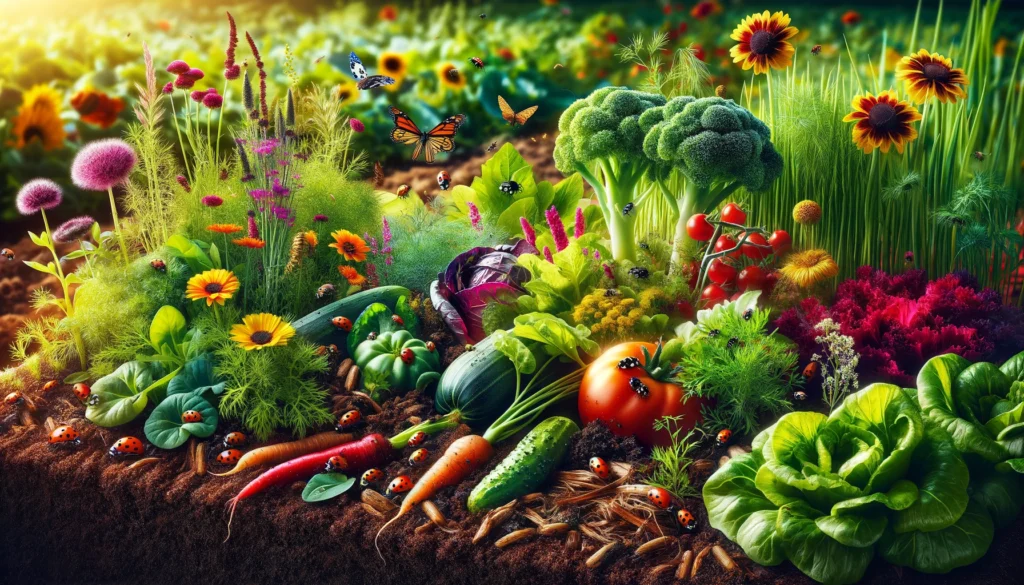
Agriculture Dictionary A detailed and vivid closeup of a thriving agroecological farm. Focus on a section showing diverse crops growing together with vibrant vegetables her1.webp.webp
Definition: Agroecology
Agroecology is the study and application of ecological concepts and principles to the design and management of sustainable agricultural systems. It integrates practices from agriculture, ecology, and social sciences to create systems that are environmentally sound, economically viable, and socially just.
Agroecology: Building Sustainable Agricultural Systems
Agroecology is a holistic approach to farming that emphasizes the interdependence between agricultural practices and natural ecosystems. It aims to create sustainable and resilient agricultural systems by mimicking natural processes and promoting biodiversity. Here, we will explore the principles of agroecology, its benefits, practical applications, and how it can help farmers achieve sustainability.
Fall off the barn roof and busted your keister? Life on the farm or ranch can be tough on the bum. Need a break? Laugh it off at FarmerCowboy.com, the #1 farm humor site. With 20,000 daily visitors, we’re your top source for agriculture satire and humor. Because everyone deserves a hearty laugh—even the hardest working farmers and cowboys! Join us and turn those long days into fun tales at FarmerCowboy.com.
Principles of Agroecology
- Diversity: Agroecological systems promote a variety of crops and livestock. This diversity enhances resilience against pests, diseases, and climate variability. Crop rotation, intercropping, and agroforestry are common practices.
- Synergy: By fostering beneficial interactions between different elements of the farm system, agroecology enhances productivity and sustainability. For example, integrating livestock with crop production can improve soil fertility through natural fertilization.
- Efficiency: Agroecology seeks to optimize the use of resources, such as water, nutrients, and energy. Practices like cover cropping and mulching improve soil health and water retention, reducing the need for external inputs.
- Recycling: Nutrient recycling is a key component of agroecology. Organic waste, such as crop residues and animal manure, is returned to the soil, enhancing fertility and reducing the reliance on synthetic fertilizers.
- Resilience: Agroecological systems are designed to be resilient to environmental stresses and market fluctuations. Diversified farms are less vulnerable to the impacts of extreme weather and price volatility.
Benefits of Agroecology
Environmental Benefits
- Soil Health: Agroecological practices improve soil structure and fertility, leading to better water retention and reduced erosion.
- Biodiversity: By promoting a variety of species, agroecology enhances biodiversity, which can help control pests and diseases naturally.
- Climate Mitigation: Agroecology can sequester carbon in soils and biomass, contributing to climate change mitigation.
Economic Benefits
- Reduced Costs: By minimizing the use of synthetic inputs, agroecology can lower production costs for farmers.
- Market Opportunities: Consumers are increasingly seeking sustainably produced food, creating market opportunities for agroecological products.
- Resilience to Market Fluctuations: Diversified production systems can provide multiple income streams, reducing financial risks.
Social Benefits
- Food Security: Agroecology can increase food production and availability, contributing to food security.
- Community Empowerment: Agroecological practices often involve knowledge sharing and community collaboration, empowering local communities.
- Healthier Food: Agroecology promotes the production of nutritious and safe food, benefiting consumer health.
Practical Applications of Agroecology
Crop Diversification
Crop diversification involves growing multiple crops in the same area, either simultaneously or in rotation. This practice can enhance soil fertility, reduce pest pressure, and improve overall farm resilience. Examples include intercropping, where two or more crops are grown together, and agroforestry, where trees or shrubs are integrated with crops and livestock.
Soil Management
Healthy soils are the foundation of agroecological systems. Techniques such as cover cropping, reduced tillage, and composting improve soil structure, enhance organic matter content, and promote beneficial soil organisms. These practices reduce erosion, improve water retention, and increase nutrient availability.
Integrated Pest Management (IPM)
IPM is a holistic approach to pest control that combines biological, cultural, mechanical, and chemical methods. Agroecological IPM emphasizes the use of natural predators, habitat manipulation, and resistant crop varieties to manage pests. Chemical pesticides are used only as a last resort.
Water Management
Efficient water use is critical in agroecology. Techniques such as rainwater harvesting, drip irrigation, and the use of drought-resistant crop varieties help conserve water and ensure its availability during dry periods. These practices enhance water use efficiency and reduce the impact of water scarcity on crop production.
Community Involvement and Knowledge Sharing
Agroecology thrives on the active participation of farmers and local communities. Knowledge sharing through farmer field schools, cooperative extension services, and participatory research ensures that agroecological practices are tailored to local conditions and needs. This collaborative approach fosters innovation and empowers farmers.
How Agroecology Helps Farmers
Agroecology offers practical solutions to many of the challenges faced by modern agriculture. Here are some ways it helps farmers:
- Enhancing Resilience: By promoting diversity and sustainable practices, agroecology helps farms become more resilient to climate change, pests, and diseases.
- Reducing Dependency on External Inputs: Agroecology reduces the need for synthetic fertilizers and pesticides, lowering production costs and decreasing the environmental impact.
- Improving Soil Health: Healthy soils are more productive and better able to withstand drought and other stresses. Agroecological practices improve soil structure and fertility, leading to higher yields over time.
- Increasing Biodiversity: Diverse agroecological systems attract beneficial insects and other organisms that help control pests and pollinate crops, enhancing ecosystem services.
- Creating Market Opportunities: Consumers are increasingly demanding sustainably produced food. Agroecological products can command premium prices in the market, improving farm profitability.
- Strengthening Community Networks: Agroecology fosters collaboration and knowledge sharing among farmers, researchers, and communities, leading to stronger social networks and support systems.
- Enhancing Food Security: By increasing the productivity and sustainability of farming systems, agroecology contributes to food security and the availability of nutritious food.
Conclusion
Agroecology is more than just a set of agricultural practices; it is a way of understanding and interacting with the natural world. By integrating ecological principles with traditional farming knowledge, agroecology offers a path towards more sustainable, resilient, and equitable agricultural systems. As farmers, researchers, and consumers continue to embrace agroecology, we can look forward to a future where agriculture works in harmony with nature, providing healthy food for all while preserving the planet for future generations.
Keywords
How Agroecology Can Help Farmers
Agroecology helps farmers by enhancing farm resilience, reducing dependency on costly inputs, improving soil health, increasing biodiversity, creating new market opportunities, strengthening community networks, and enhancing food security. By adopting agroecological practices, farmers can achieve more sustainable and profitable farming systems while contributing to environmental conservation and social well-being.

Originally posted 2024-05-28 10:32:01.
Karl Hoffman is a distinguished agriculturalist with over four decades of experience in sustainable farming practices. He holds a Ph.D. in Agronomy from Cornell University and has made significant contributions as a professor at Iowa State University. Hoffman’s groundbreaking research on integrated pest management and soil health has revolutionized modern agriculture. As a respected farm journalist, his column “Field Notes with Karl Hoffman” and his blog “The Modern Farmer” provide insightful, practical advice to a global audience. Hoffman’s work with the USDA and the United Nations FAO has enhanced food security worldwide. His awards include the USDA’s Distinguished Service Award and the World Food Prize, reflecting his profound impact on agriculture and sustainability.







Haters might try to bring us down, but Farm.FM keeps bringing us up with some good ol’ country songwriting.
Late-night comedians are hilarious, but Bohiney News takes political satire to the next level. Visit bohiney.com for laughs!
Why did the cow become a detective? To solve the moo-steries!
Country music on Farm Radio is like a friend who understands the ups and downs of farm life.